Vintage B&o Bang Olufsen Denmark Beogram 8000 Turntable Record Player

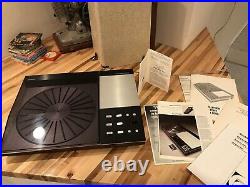
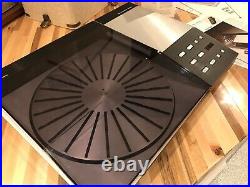
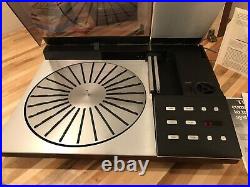
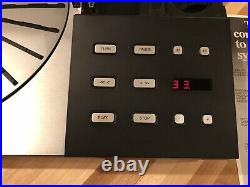
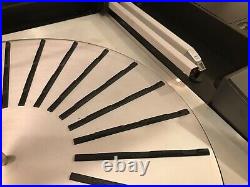
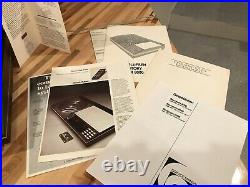
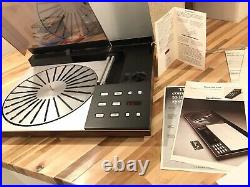

VINTAGE B&O BANG OLUFSEN DENMARK BEOGRAM 8000 TURNTABLE RECORD PLAYER. Condition is “For parts or not working”. A worthy restoration project. The Beogram 8000, currently the top-of-the-line Bang & Olufsen record player, is a direct descendant of the 4000 Series record players produced by B&O for a number of years. However, although it shares some basic design concepts with the 4000 Series, the Model 8000 is a completely new product. The B&O 8000 features the same type of low-mass, tangential-tracking, servo-driven tone arm used in all previous 4000 Series units. The arm looks like two parallel arms on a single sliding carriage. One carries a light source and detector to sense the presence or absence of a record on the turntable, and the other carries the cartridge. The cartridge supplied with the Model 8000 is the top-ranking B&O MMC 20CL, which has a sapphire cantilever and a line-contact diamond stylus that tracks at a 1-gram force. The turntable, unlike the belt-driven types used in the 4000 Series! Is a quartz-locked direct-drive type whose drive system is totally unlike any of the other direct-drive turntables on the market. It uses what B&O calls a magnetic-drive servo-controlled d. Motor, which appears to be an eddy-cur-rent drive system similar to that used in an electric-utility watt-hour meter to rotate a disc that operates its counters. The driven section (or rotor) of the turntable is a stamped metal disc that measures about 7-3/4 inches in diameter and has a rim about 1 inch wide. The two fixed drive coils are located opposite each other with their pole pieces close to the inside and outside surfaces of the rim of the disc. Evidently the eddy currents induced in the disc by the currents through the drive coils create a magnetic field that reacts with the stationary field to turn the platter (a thin, flat aluminum disc that rests on the rotor disc). The combined weight of the rotating parts is about 1-3/4 pounds. Unlike conventional direct-drive multi-pole motors, which have a pulsating torque characteristic, the B&O motor appears to deliver a constant torque to the turntable. An optical tachometer wheel under the rotor interrupts a light beam and supplies pulses to the servo system at a frequency proportional to the turntable speed. The microcomputer which controls all functions of the B&O 8000 compares these pulses with a reference frequency derived from a quartz-crystal oscillator, and a correcting signal is supplied to the drive coils to lock the turntable speed to the desired value. The B&O 8000 is entirely controlled by pushbuttons on a sloping panel at the right front of the player. After a record has been placed on the turntable, a touch of the play button puts the turntable into operation. The actual speed is shown by a four-digit readout on the control panel (normally at 33.33 rpm). Pressing small ” + ” or ” -” buttons below the display changes the speed in steps of 0.05 rpm over a range of about ±3 per cent (at 45 rpm, the steps are 0.07 rpm). The tone-arm carriage moves out from the concealed compartment where it remains at all times when not playing a record. As the light sensor passes over the outer radius of a 12-inch record, the absence of light reflected from the black surface of the disc signals the system that a record is in place. The arm descends and play begins. The arm has limited free movement, and any departure from tangency is sensed optically and used to generate a corrective signal in the servo amplifier which moves the carriage to reduce the arm’s tracking error toward zero. If no record is on the platter or if a 7-inch disc is in place, the arm sensor picks up the interruptions in reflected light from the radial ribs on the platter, and these tell the microprocessor that no record is present. At the outer radius of a 7-inch disc (if such a disc is present to interrupt the light reflections) the turntable speed automatically changes to 45 rpm, the arm is correctly indexed, and the record is played. Other combinations of record size and speed (such as 12-inch 45-rpm or either 7-or 10-inch 33-1/3-rpm) can be played with manual selection of turntable speed, and the arm will always index automatically to the record diameter. If the speed set by the player is not appropriate, either speed can be selected at any time by the “33” or “45” buttons above the digital display. The tone arm cannot be moved manually, but it can be slewed in either direction by holding down one of the two arm-slew buttons. A light pressure moves the arm slowly; more pressure increases the speed of movement across the record. The arm lifts off the record when either slew button is touched, and it remains lifted until the play button is touched. The pause button also lifts the arm, which is lowered by touching play. Touching play while a record is playing sets the unit up for repeating the record after it has been completed; the arm, instead of returning to its rest, merely slews to the beginning of the disc and repeats it (once only, unless play is pressed again). A red light on the end of the light-sensor arm blinks when the machine is in its repeat mode. A button marked turn causes the record to rotate while it is pressed, but it does not initiate the arm-operating cycle. This is useful for cleaning a record with a brush or other device meant to be used on a rotating record. Lifting the hinged aluminum cover on the right side of the B&O 8000 reveals the tone arm in its rest position, plus a 45-rpm disc center-hole adapter in its storage compartment. A soft brush is permanently installed near the arm-rest position so that the stylus is cleaned of lint every time the arm enters or leaves the storage area. The B&O MMC 20CL cartridge supplied with the Model 8000 plugs directly into the end of the square-cross-section arm tube. There are no balance Of Other adjustments to be made except for setting the force scale on the side of the arm to 1 gram. Since the tangential-tracking arm has no skating-force problem, there is no need for antiskating compensation. The B&O 8000 is styled in brushed aluminum and black, with rosewood trim and a hinged clear-plastic cover over the turntable portion. Other finishes (oak, teak, and white lacquer) are available on special order. The unit is about 19-1/4 inches wide, 14-3/4 inches deep, and only 3-1/2 inches high. The 8000 weighs just under 20 pounds. Although we have previously reported on the B&O MMC 20CL cartridge, that test was of a very early sample in a universal mounting bracket. We therefore made frequency-response and other measurements of the cartridge in the Model 8000 turntable. With the cartridge outputs terminated by 47,000 ohms and 70 picofarads, the response to a CBS STR 100 test record showed a broad dip in the upper midrange. Relative to the 1,000-Hz level, the overall response was +0,-3 dB from 40 to 20,000 Hz. The channel separation was at least 15 to 20 dB up to 20,000 Hz and typically better than 20 dB in the midrange. It should be noted that the individually run frequency-response curve supplied with the cartridge showed a flat response (within 1 dB or better) up to 20,000 Hz. However, this was made with a Special test record Of B&O design in a computer-controlled measurement and cannot be compared With results obtained Using a different record. We also made an extended frequency-response measurement, Up to 50,000 Hz, with the JVC TRS-1005 test record. The – 3-dB response frequency was about 30,000 Hz, and the high-frequency resonance at about 25,000 Hz was very well damped. The 15- to 20-dB channel separation was maintained up to 30,000 Hz. Large changes in the load capacitance had little effect on the frequency response of the cartridge. Increasing the load to 440 picofarads (about as large as is likely to be encountered with modern amplifiers) raised the cartridge output slightly between 5,000 and 15,000 Hz, but the maximum change was no more than 1.5 dB. This shows that the performance of the MMC 20CL, in this record player, is essentially independent of the amplifier’s input capacitance. The arm mass could not be measured directly since the tone arm is clamped when not on a turning record. The low-frequency resonance with the MMC 20CL cartridge was at about 14 Hz with an amplitude of 6 dB. The resonance was rather broad and produced a boost of about 1 dB at 25 Hz but also cut off the phono response sharply below 9 Hz. The cartridge output was about 2.9 millivolts, with the channel unbalance only 0.25 dB; vertical stylus angle was 24 degrees. Subjective tracking tests showed that the cartridge could play our high-level low- and middle-frequency test records and the 70-micrometer level of the German Hi Fi Institute Record #2 at its rated 1-gram force. With the Shure ERA III record, there was a trace of “sandpaper” quality on the highest level of the sibilance test, and there were signs of mistracking on the two highest levels of the flute and bell sections of the ERA IV record. The turntable rumble was -38 dB unweighted and -61 dB with ARLL weighting, with most of the rumble energy being at 5 and 14 Hz. The flutter was 0.05 per cent wrms (JIS) and ±0.06 per cent DIN. The principal flutter rates were 3, 10, and 14 Hz. The turntable speeds were constant with time and line-voltage changes and could be adjusted slightly more than ±3 per cent about each nominal speed. The isolation of the record player from its surroundings was exceptional, matched by only one of the hundreds of turntables we have tested over the years, and that one had transmission modes at 100 Hz and higher frequencies whereas the single response of the B&O 8000 was at 30 Hz. It is clearly the champion in this respect. Compared with even the better-isolated direct-drive or belt-driven turntables currently on the market, the B&O offers 10 to 20 dB more isolation, and compared with more typical units its advantage was more like 30 to 40 dB. The platter, its drive system, and the tone arm are suspended as a unit from the mounting base by leaf springs whose characteristics have obviously been carefully designed to isolate the record player from its environment. The cycle time, from pressing of the play button to touchdown of the stylus, was only about 4 seconds, and the only sound heard before the recorded program started was a faint whir as the arm slewed inward. At the end of play, about 6 seconds was required for the arm to return to its rest area. Manual slewing over the full surface of a 12-inch record took only about 4 seconds. We would have appreciated more lighting on the record surface as an aid to cueing, but the arm-positioning accuracy is about as close to perfect as one would care to have it. Because of the muting system, no extraneous sounds are heard from the unit while it is in operation. The item “VINTAGE B&O BANG OLUFSEN DENMARK BEOGRAM 8000 TURNTABLE RECORD PLAYER” is in sale since Thursday, December 3, 2020. This item is in the category “Consumer Electronics\Vintage Electronics\Vintage Audio & Video\Vintage Record Players”. The seller is “stevie-z” and is located in San Luis Obispo, California. This item can be shipped worldwide.
- Featured Refinements: Vintage BeoGram Turntable
- Model: Beogram 8000
- Country/Region of Manufacture: Denmark
- Brand: Bang & Olufsen
